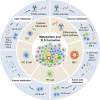The impact of metabolic reprogramming on tertiary lymphoid structure formation: enhancing cancer immunotherapy
- PMID: 40223062
- PMCID: PMC11995586
- DOI: 10.1186/s12916-025-04037-7
The impact of metabolic reprogramming on tertiary lymphoid structure formation: enhancing cancer immunotherapy
Abstract
Background: Cancer immunotherapy has achieved unprecedented success in the field of cancer therapy. However, its potential is constrained by a low therapeutic response rate.
Main body: Tertiary lymphoid structure (TLS) plays a crucial role in antitumor immunity and is associated with a good prognosis. Metabolic reprogramming, as a hallmark of the tumor microenvironment, can influence tumor immunity and promote the formation of follicular helper T cells and germinal centers. However, many current studies focus on the correlation between metabolism and TLS formation factors, and there is insufficient direct evidence to suggest that metabolism drives TLS formation. This review provided a comprehensive summary of the relationship between metabolism and TLS formation, highlighting glucose metabolism, lipid metabolism, amino acid metabolism, and vitamin metabolism.
Conclusions: In the future, an in-depth exploration of how metabolism affects cell interactions and the role of microorganisms in TLS will significantly advance our understanding of metabolism-enhanced antitumor immunity.
Keywords: Cancer immunotherapy; Germinal center B cell; Metabolic reprogramming; T follicular helper cell; Tertiary lymphoid structure.
© 2025. The Author(s).
Conflict of interest statement
Declarations. Ethics approval and consent to participate: Not applicable. Consent for publication: Not applicable. Competing interests: The authors declare no competing interests.
Figures



Similar articles
-
Targeting Tertiary Lymphoid Structures for Tumor Immunotherapy.Methods Mol Biol. 2018;1845:275-286. doi: 10.1007/978-1-4939-8709-2_16. Methods Mol Biol. 2018. PMID: 30141019
-
Tertiary Lymphoid Structures as a Predictive Biomarker of Response to Cancer Immunotherapies.Front Immunol. 2021 May 12;12:674565. doi: 10.3389/fimmu.2021.674565. eCollection 2021. Front Immunol. 2021. PMID: 34054861 Free PMC article. Review.
-
STINGing the Tumor Microenvironment to Promote Therapeutic Tertiary Lymphoid Structure Development.Front Immunol. 2021 May 13;12:690105. doi: 10.3389/fimmu.2021.690105. eCollection 2021. Front Immunol. 2021. PMID: 34054879 Free PMC article. Review.
-
Mature tertiary lymphoid structures: important contributors to anti-tumor immune efficacy.Front Immunol. 2024 Jul 4;15:1413067. doi: 10.3389/fimmu.2024.1413067. eCollection 2024. Front Immunol. 2024. PMID: 39026670 Free PMC article. Review.
-
An Introduction to Tertiary Lymphoid Structures in Cancer.Methods Mol Biol. 2025;2864:1-19. doi: 10.1007/978-1-0716-4184-2_1. Methods Mol Biol. 2025. PMID: 39527214 Review.
References
-
- Zhang J, Huang D, Saw PE, Song E. Turning cold tumors hot: from molecular mechanisms to clinical applications. Trends Immunol. 2022;43(7):523–45. - PubMed
Publication types
MeSH terms
LinkOut - more resources
Full Text Sources
Medical

